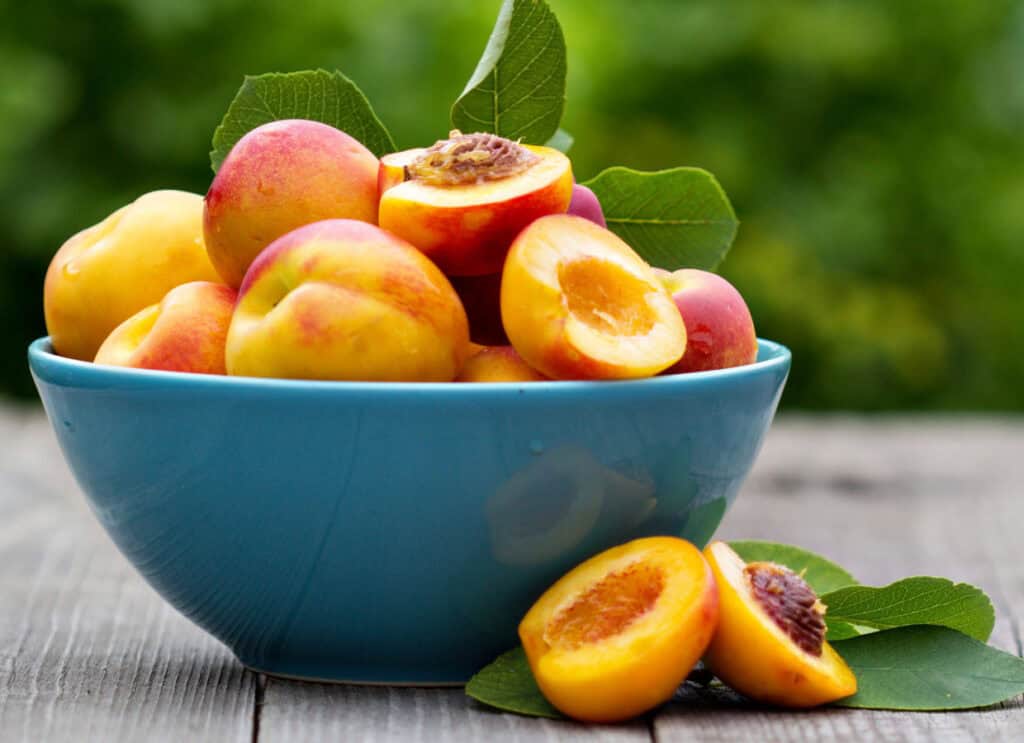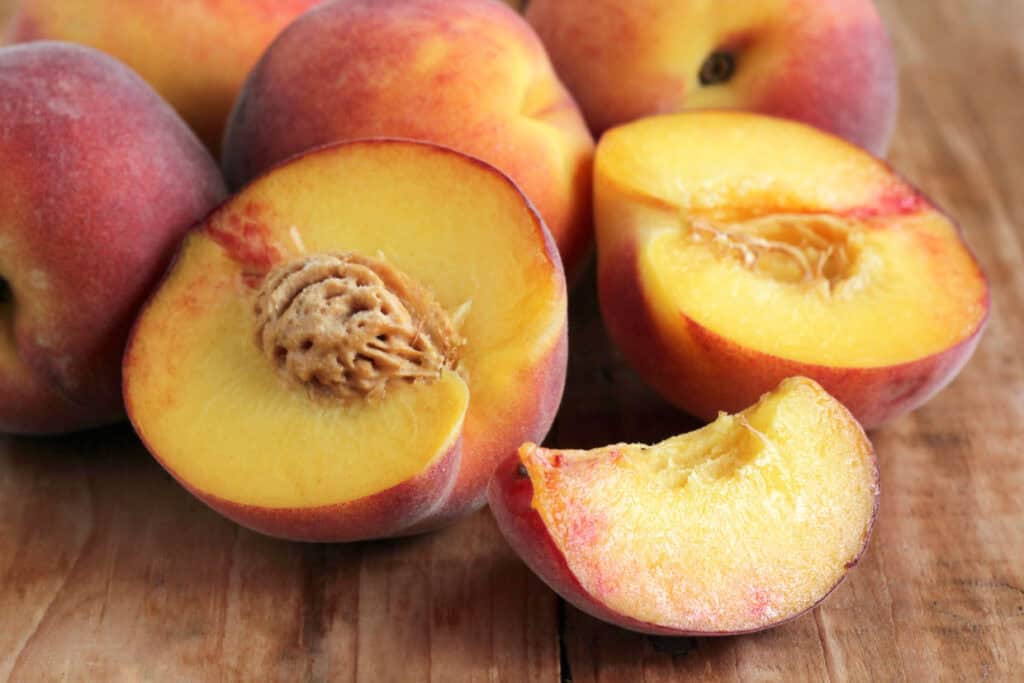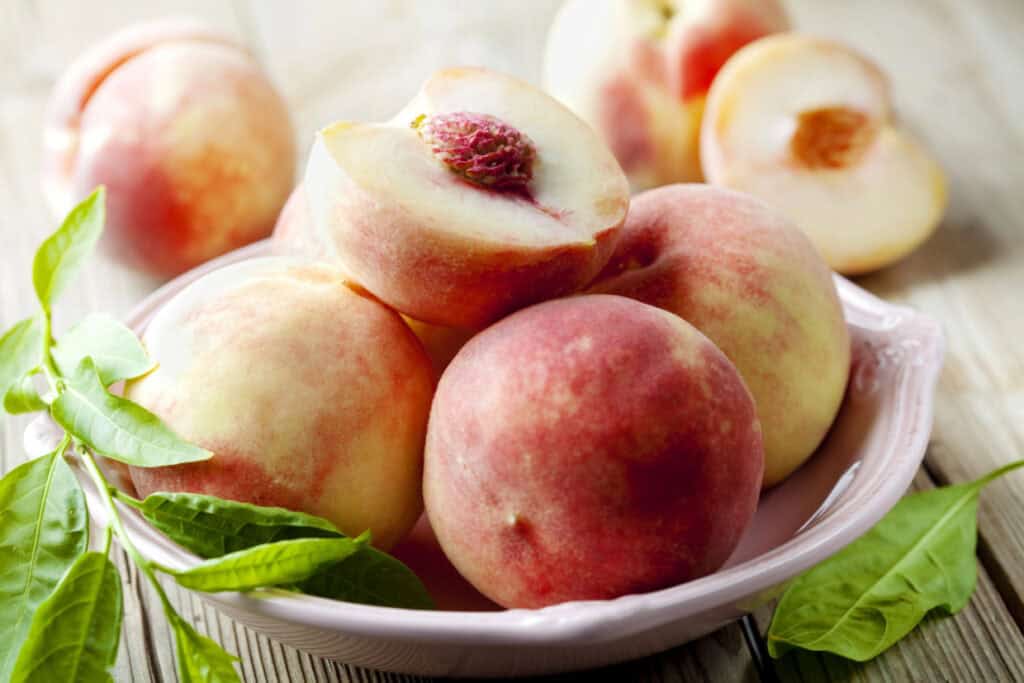Savoring the flavors of the different types of peaches goes beyond that first sweet bite. There’s a perfect peach to savor from color and shape to size and taste. Let’s explore the delightful diversity of peaches and how to pick the perfect one for a juicy summer treat.

Summer isn’t the same without sinking your teeth into a ripe peach. Some peaches excel when baked into pies and crisps, while others hold their own on the grill or add a touch of sweetness to salads.
Over 2,000 peach varieties have distinct features like color, size, flavor and flesh firmness. Originally native to Asia, these juicy fruits grow on deciduous trees. Like other stone fruits, peaches have a pit surrounded by red, orange or pink skin with white or yellow flesh — many varieties also have fuzzy outer skin. While they ripen after picking, peaches are a summertime treat, typically available from mid-June to August. Additionally, did you know you can freeze peaches to enjoy their sweetness all year round?
Three categories of peaches
Peaches are classified into three categories based on how the flesh separates from the pit: clingstone, freestone and semi-freestone. Each category offers unique advantages depending on how you plan to enjoy the peach.
- Clingstone peaches: As their name suggests, they have flesh that tightly adheres to the fruit’s pit, making them a bit trickier to cut. However, their sweeter and juicier nature makes them perfect for desserts, jams, jellies and purees. These peaches have bright yellow flesh with red flecks closer to the stone. They are mostly available mid-season and typically found in local farmers’ markets where these trees are commonly grown.
- Freestone peaches: These are the most common variety in grocery stores. The flesh is easily separated from the pit, making them a favorite for eating fresh and slicing into desserts and salads. Their firm texture also makes them perfect for baking, grilling and salsas. This variety is larger and has a longer harvest season, from late May to October.
- Semi-freestone peaches: As the name implies, semi-freestone peaches are a hybrid of clingstone and freestone varieties. The flesh partially separates from the pit, making them versatile for eating fresh and cooking.

“I love freestone peaches because I just cut them in half, easily remove the pit and eat! They’re great just like that, or sometimes I put them in the air fryer and top it with whipped cream. The flavor is so sweet and delicious.”
— Gena, Gingercasa.com
Yellow peaches vs. white peaches
Even with the abundance of peach varieties, you can choose between yellow or white flesh peaches. The different colors have unique flavors and textures.
Yellow peaches
The main varieties of yellow peaches are Redhaven, Elberta, Georgia Belle, Red Globe and O’Henry. These varieties are all freestone peaches.
- Flesh color: Yellow to golden-yellow.
- Flavor: Typically sweet with a slightly acidic taste.
- Texture: Firm and juicy.
- Common uses: Ideal for fresh eating, baking, grilling, canning and making preserves.
- Availability: Widely available in grocery stores and farmers’ markets, especially during summer.
- Appearance: They often have a red blush over a yellow background.
- Harvest season: Typically harvested from late spring to early fall.
White peaches
Arctic Supreme, Snow Giant, and Arctic Star are the main varieties available. All of these varieties are semi-freestone.
- Flesh color: Pale to light yellow, sometimes with a pink blush.
- Flavor: Sweeter and less acidic than yellow peaches, with floral undertones.
- Texture: Soft and juicy, with a melting texture.
- Common uses: Best enjoyed fresh, but they are suitable for baking, desserts and making jams.
- Availability: They are found in grocery stores and farmers’ markets during summer but are less common than yellow peaches.
- Appearance: Generally, they have smoother skin with a light blush or no blush.
- Varieties: Types include Arctic Supreme, Snow Giant and Arctic Star.
- Harvest season: Typically harvested from late spring to early fall, overlapping with yellow peach season.

Donut peaches
This type of peach, also known as a flat peach, can be clingstone or freestone. This peach is a versatile choice for various culinary uses.
- Flesh color: Yellow or white flesh.
- Flavor: They are exceptionally sweet due to their low acid-to-sugar ratio.
- Harvest season: They are typically considered the sweetest variety of peach available and are in season between July and August.
- Appearance: Donut peaches have a unique flat and saucer-shaped appearance, with a small pit in the center and dimpled ends.
- Texture: Their texture is often described as tender and juicy, with a slight almond flavor, making them a favorite snack.

“My favorite thing to bake with peaches is peach blueberry crisp. Fresh summer peaches add sweetness and pair perfectly with blueberries topped with a butter crumble. I prefer freestone peaches since they’re easier to work with, but I will happily use whatever is fresh in season.”
— Lisa Wells, Cook Eat Well
Choosing a good peach
Selecting the perfect peach requires engaging your senses. Here’s how to identify a peach at its peak of flavor and freshness:
- Choose peaches that are firm but yield slightly to gentle pressure when squeezed.
- Look for a fragrant aroma that indicates ripeness, especially near the stem end.
- Avoid peaches with green patches or bruises; pick one with vibrant colors instead.
- The background color should be creamy or golden, which indicates ripeness.
- If you plan on eating peaches immediately, select ones that give a little under gentle pressure near the stem and have a sweet aroma.
- For later consumption, choose slightly firmer peaches to allow for ripening at home.
Peaches are a summertime favorite, perfect for enjoying fresh or using in delicious desserts like fresh peach ice cream. You can also add white and yellow peaches to this peach tart. Both are delicious ways to enjoy peaches.
Many different types of peaches come in all shapes, sizes and flavors, making them a crowd-pleaser. Whether baking a pie, throwing a salad or grabbing a juicy one for a snack, there’s a perfect peach for every taste bud. So next time you’re at the market, don’t be afraid to explore the world of peaches — your taste buds will thank you.
Jere Cassidy is the writer and recipe developer behind the blog One Hot Oven. A passion for all things food-related led her to culinary school to expand on her baking skills and now to sharing easy recipes for all home cooks and bakers of all skill levels. When not in the kitchen, Jere’ likes to travel far and wide to find delicious food.